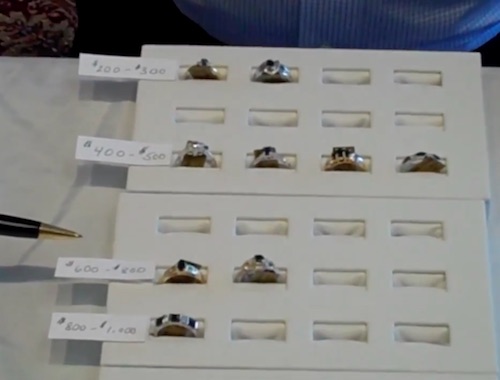Articles and News
‘BIG’ Ideas For Moving Non-Performing Inventory | February 17, 2016 (0 comments)

Scottsdale, AZ—Every jeweler has inventory that just won’t move. Whether it was a buying gamble that didn’t pay off or a trend that fizzled out sooner than your stock ran out, even the savviest jewelers have a few dogs in their stores. Many jewelers have more than a few dogs—tying up both cash and space that could be used for faster-turning and more profitable merchandise.
At the Centurion Scottsdale show, Abe Sherman, president of BIG (Buyers Intelligence Group), addressed the issue of dealing with non-performing inventory. Speaking at two special retailer education sessions, Sherman outlined five possible ways to get those dogs out of the store: a sale, a stock balance with the vendor, spiffing the staff, donating to a good cause, or melting it down.
Having a sale will clear out the goods, but it’s a short-term fix. Stock balancing, meanwhile, has its pros and cons. The upside is that you don’t have to give your margins to discounting like you do for a sale—but the downside is that you often have to buy two or three times as much as you’re trading back, which doesn’t help if you no longer buy from that vendor or you’re trying to phase it out.
Spiffing the staff to move out the dogs is a viable option, as is donating the goods to charity. But proceed with caution and beware the pitfalls, warned Sherman—you don’t want your staff to pressure customers to buy something they don’t love just to get the spiff, and you don’t want something grossly outdated to represent your brand even if it is a charitable donation.
You can get the staff on board with spiffs if you go about it the right way, he said. As soon as you see the inevitable eye rolls, those are likely because the staff doesn’t understand why it’s so important.
“Explain why it’s important to sell them; that selling this equals cash for something new. Make it a team-building effort so that everyone is successful when the dogs sell,” he suggested. Fun ideas such as an ugly jewelry contest have been used successfully, he said.
Finally, melting goods down is not the attractive option it was a few years ago when gold peaked near $2,000.
But before resorting to clearance tactics, try remerchandising, said Sherman. “You sell thousands of items each year. Some portion of your inventory isn’t selling. Why? Is it a perceived value problem?”
What is the perceived value of the slow movers when laid out with other merchandise? Is it that they’re old and boring and people don’t pay attention to it because there’s something newer and more exciting? Solving the perceived value issue begins with pricing, said Sherman. He asked class participants how they price their merchandise.
“Independent jewelers typically buy [merchandise] and price after, based on their cost. Chains start with a retail price they want to sell for and buy merchandise to hit it,” he said. "Pricing isn’t an exact science. We guess, and sometimes we’re right and sometimes we miss. And if something’s popular we bring it back," he said.
But a critical mistake many jewelers make is to raise prices on fast-selling merchandise. “If it’s popular, don’t keep upping the price. Keep it the same!” he emphasized. If the category and price point is doing well, add more jewelry in that category. “Merchandise to it!” he stressed. “Marking up repeatedly hits the Peter Principle of jewelry—you will hit a point where people won’t buy. Then what? You mark down? That’s bad juju!”
Sherman next demonstrated a technique he calls “balance to buy.” Put pieces of the same price together in the case, and line up your all inventory in rows by price to see what customers are buying. “Line it up for every category in the store. You’ll find clusters and gaps,” he explained. Put the aging inventory in the same row, but move it to the far right column. Buff and polish and ultrasonic clean it, then look at its perceived value. Re-pricing inventory does not automatically mean lowering the price, said Sherman.
“You don’t just re-price willy-nilly. Look at it and price it visually. For example, a nice thick ring can go up in price, but a small ring, even if it’s a better quality [stone], should go down. “Sometimes you have to walk away from the data and look at the jewelry.”

Line each category of goods up by price point, says Sherman. Move dated merchandise to the right column.
But data helps with your buying plan—a similar process to Sherman’s re-pricing technique. “Your data helps you see where your customers are spending, see where you are spending, and to see if what you own is aging, and why. Don’t go to a show without knowing those numbers!” he stressed.
Where do you want to improve your margins? Watches and bridal are two categories that aren’t easy to boost margins, though it is doable. It’s much easier to do it with diamond fashion and color, he said. “Determine a retail price first [based on your numbers that show what people are buying], then figure out your [desired] margin, then find your cost.”
Sherman emphasized again the importance of perceived value. “It’s very tough for customers to see why three pieces have prices all over.”
Will you leave room in your pricing for discounting or negotiation? That depends on the nature of your business, says Sherman. There’s no set right or wrong answer. He recommends rounding out prices, but if a store has very detailed prices, such as $1212.15, they can justify their story by presenting it as the lowest possible markup—which is a viable strategy for competing with the Internet.
“Customers shop online first. They will know if it’s cheaper elsewhere before you do,” he warned. This is especially true of branded items. Finally, he said the “killer price point” (e.g. sweet spot) for almost every jewelry store across the country is between $1,000 and $1,500.
For more detail on Sherman’s Balance To Buy strategy, click here. (Note: scroll to the lower right on the BIG site page to see the video that demonstrates the points Sherman made in his presentation at Centurion.)







